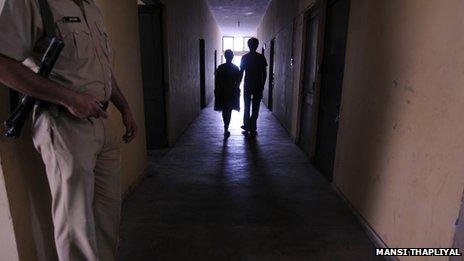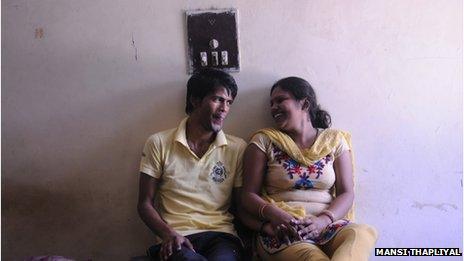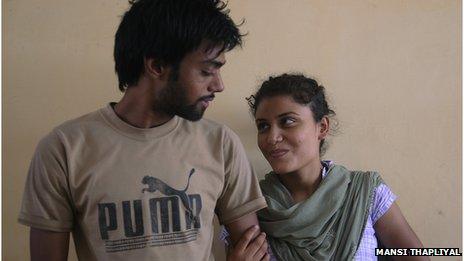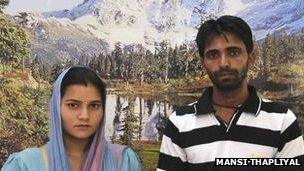A hideaway for India's rebel couples
- Published

The runaway couples live under police protection in shelter homes
Indian couples that have angered their families by pursuing "forbidden" relationships are increasingly seeking refuge in special shelters run by the police.
The pale 19-year-old girl, Krishna, is sitting in a small room at a police barracks in northern Haryana state.
All life is wilting in the soaring summer heat outside. A glossy poster of the Swiss Alps mocks us from the whitewashed wall.
When asked whether her family could really kill her husband, because she married outside her caste without permission, she hides her head in the folds of her long diaphanous scarf and nods.
"Yes, yes, they can."
How? "Oh, it's very easy to get a gun. In my village [in Uttar Pradesh state] guns go off even during small fights. Killing is never difficult," says Krishna, deadpan.
Her family had refused to accept her relationship with Sonu, a 22-year-old barber from a lower caste, and had arranged her marriage with another man, whom she had never met.
Earlier this month, Krishna, daughter of an out-of-work father and a homemaker mother, slipped out of her Saharanpur home on a sultry June night, and took a bus to her boyfriend's house in neighbouring Haryana.
The next morning, they got married at a local temple in Kurukshetra, went to the court and sought police protection.
The court ordered the police to give the couple shelter at one of the many homes to protect runaway couples that dot Haryana. Last year more than 200 couples were given shelter in such homes. And they keep pouring in.
Love is difficult - and dangerous - in large swathes of India where patriarchy, kinship, casteism and family honour hold sway.
A female is "always under guardianship", says social scientist Prem Chowdhury. As a girl, under her parents, and as a woman, under her husband. "Any breach of this ideology of guardianship, control, and dependence, however small, is considered to be very threatening."
Relationships in the same village, outside the caste and faith, and within the same gotra (clan on father's side), are forbidden by families and hardline village councils. Kangaroo courts set up the councils often sanction killings of such "erring" couples to redeem honour.
But, despite the odds, love and longing in the villages and small towns of India is changing like never before.
Young men and women across the divides are braving centuries of social resistance and - helped by the mobile phone and social networking sites like Facebook - are falling in love in the villages and small towns of India in greater numbers than ever before.
They are breaking what writer Arundhati Roy, in her Booker-prize winning novel, The God of Small Things, described as "Love Laws" that "lay down who should be loved … And how … And how much".
Shallu, 22, and Subhas, 27 are a perfect example of the changing colours of love in India's teeming towns and villages.

Subhas and Singhla fell in love over Facebook
They lived 120km (74 miles) apart - Shallu, a chatty, personable, daughter of a grocer in Ambala, and Subhas, a quiet and determined son of a government worker, in Karnal.
Shallu was studying for a degree in computer applications, and Subhas trying to pick up a diploma in marketing when Cupid struck.
Two years ago, says Shallu, she sent a friend request to Subhas on Facebook from her cheap Nokia phone. They had a common friend, but Subhas's Facebook page did not have his picture - "He had a picture of a baby on his profile, he was so shy," she giggles.
Three months later, she called, and they met at a Coffee Cafe Day shop in Ambala.
"We got lucky by chance. We became friends, and then we became boyfriend-girlfriend," Shallu tells me.
When her family came to know about the relationship, they took away her phone.
"My family told me: 'We will get you a hi-fi boy [handsome, rich boy]'. I don't want any hi-fi boy. I told them, I just want to marry my boyfriend."
She chose to escape on 22 May. She left home in the morning to sit for an examination, and instead took the bus to Karnal, where Subhas was waiting. They got married at a local temple.
Outside the placid confines of the shelter home, the storm is still raging. The couple say members of Shallu's family went to Subhas's house and asked them to "return" their girl.
"If she doesn't return home, things can happen," a relative told Subhas's family.
Life in a shelter home is a dismal honeymoon. Two to three couples are cooped up in a room, with an armed policeman on guard outside. They kill time by playing ludo, and bonding over their shared travails. There are stolen moments of touching and holding hands.
"Love struggles when there's no space or privacy," says Harjinder, 21, who is here with his newlywed runaway bride, Navjot, 21.

Harjinder fell in love with Navjot when she became a neighbour in his village
The men, in T-shirts and faded denims, look tetchy. The women, in bright salwar kameez and armfuls of colourful plastic wedding bangles, are more cheery.
So Shallu, tongue firmly in cheek, wonders why her family can't accept her marriage to the man she loves.
"I have saved my father one million rupees ($18,000) which he had stashed away as dowry for my wedding. They should be happy, isn't it?," she titters.
They obviously aren't.
That's why Harjinder, who worked as a photographer at a small studi in Mohali, and Navjot Kaur are holed up inside a home. Harjinder's "crime" - he fell in love with Navjot who moved into his village.
"My family said," says Harjinder, "you can't marry a girl who lives in your village. That we should live like brothers and sisters. Falling in love is a scandal."
So Navjot eloped in June and got married in Karnal in June, sparking threats from one relative.
"He has threatened my family. They've filed a police complaint that I kidnapped Navjot," says Harjinder.

Keval and Himani met on a train journey
"I don't care as long as she loves me. It's a good thing to fall in love, no? Navjot was my first and last girlfriend. People can laugh at our fate, but this is very, very serious."
It is. How else do you explain Keval, 23, an electrician from Karnal, driving 100km to catch a glimpse and snatch a "two-minute conversation" with his girlfriend Himani, a grocer's daughter, in her village?
They had met as complete strangers on a train journey. Two months later, they were hopelessly in love despite the fact that Keval belonged to a lower caste.
"We never had dreams or hopes of falling in love. Now I think it's the best thing that has happened to us. Falling in love made me realise how horrible caste is," says Himani.
The audacity of love is clashing with primordial loyalties of caste and kinship in India's heartland. But love is strong and growing, and is mounting a serious challenge to such loyalties.
It is time to leave. I ask a spry policewoman escorting the couples to their room what she thought about them.
"Everything is changing, sir," says Parvin Kumari. "Foreign culture, TV, mobile phones are changing Indian culture.
"The pyar ka bhoot (spectre of love) is on the rampage here. The spectre is all around us."